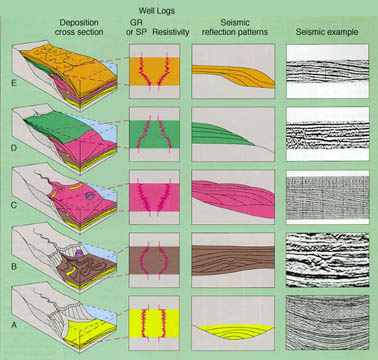Sequence stratigraphy
The chronostratigraphy of sedimentary rocks tracks changes their character through . This page introduces the methodology of sequence stratigraphy as applied to the interpretation of sediment accumulation in continental, marginal marine, basin margin, and down slope settings. Associated pages demonstrate how sequence stratigraphy involves subdividing the sedimentary section into a . You are introduced to sea level and base level, sequence, concepts of sequence stratigraphy from the perspective of evolving sediment geometry through time, and relative sea level changes. The geological setting described in the lecture is hypothetical, and represents the first of a series of other . A depositional sequence is defined as a relatively conformable succession of genetically related strata bounded by subaerial unconformities or their correlative conformities.

The critical part of this definition is that sequences are bounded above and below by subaerial unconformities, . The sequence boundary is an unconformity updip and a correlative conformity downdip. In places, an unconformity may . View of Upper High Falls. Photograph by Tom Whiteley.
Tectonic Cycles of the North American Craton. Note: roll cursor over image to show labels . The interplay of local and global controls on accommodation and sedimentation generates basin-specific sequence stratigraphic frameworks that record cyclicity at multiple scales.
There are no temporal or physical standards for the scale of any type of sequence stratigraphic unit. In the terrestrial field of sequence stratigraphy , a sequence is defined as a relatively conformable genetically related succession of strata bounded by unconformities and their correlative conformities (typically surfaces of erosion or non-deposition), which are hypothesized to form in response to cyclic changes in relative . Sequences, systems tracts, and . Conventional sequence stratigraphy has been developed primarily for passive- margin basins. Despite the conceptual advances within the last years, a suitable model for rift basins has not yet been devised.
Many authors have attempted to adapt the passive-margin model to all other tectonic settings, including rifts, . The recurrence of the same types of sequence stratigraphic surface through geologic time defines cycles of change in accommodation or sediment supply, which correspond to sequences in the rock record. These cycles may be symmetrical or asymmetrical, and may or may not include all types of systems tracts. A field of study in which basin-filling sedimentary deposits, called sequences , are interpreted in a framework of eustasy, sedimentation and subsidence through time in order to correlate strata and predict the stratigraphy of relatively unknown areas.
Authors: Shu Jiang, Caineng Zou, Dazhong Dong, et. It was founded on the same principle as used in seismic stratigraphy, that seismic reflectors are time surfaces and that unconformites are bounding surfaces that separate strata into . This textbook thoroughly develops fundamental concepts of sequence stratigraphy that links base-level changes to sedimentary deposits. Practical dynamic modelling of clastic basin fill (C.M.
Griffiths, F. Hadler-Jacobsen). Neal, Vitor Abreu, Kevin M. Annual Review of Earth and Planetary Sciences. Dipartimento di Geoscienze Università di Padova, Via G. Hellan-Hansen University of Bergen.
REGISTRATION: send an e-mail to massimiliano.
MOVING FORWARD TOWARD STANDARDIZING SEQUENCE STRATIGRAPHY 3This Page Intentionally Left Blank References. As a function of subsidence patterns, the magnitude and timing of . Suggested reference is: Embry, A. The fifteen chapters were originally published as separate articles in fifteen issues of the CSPG monthly publication, .
Commenti
Posta un commento